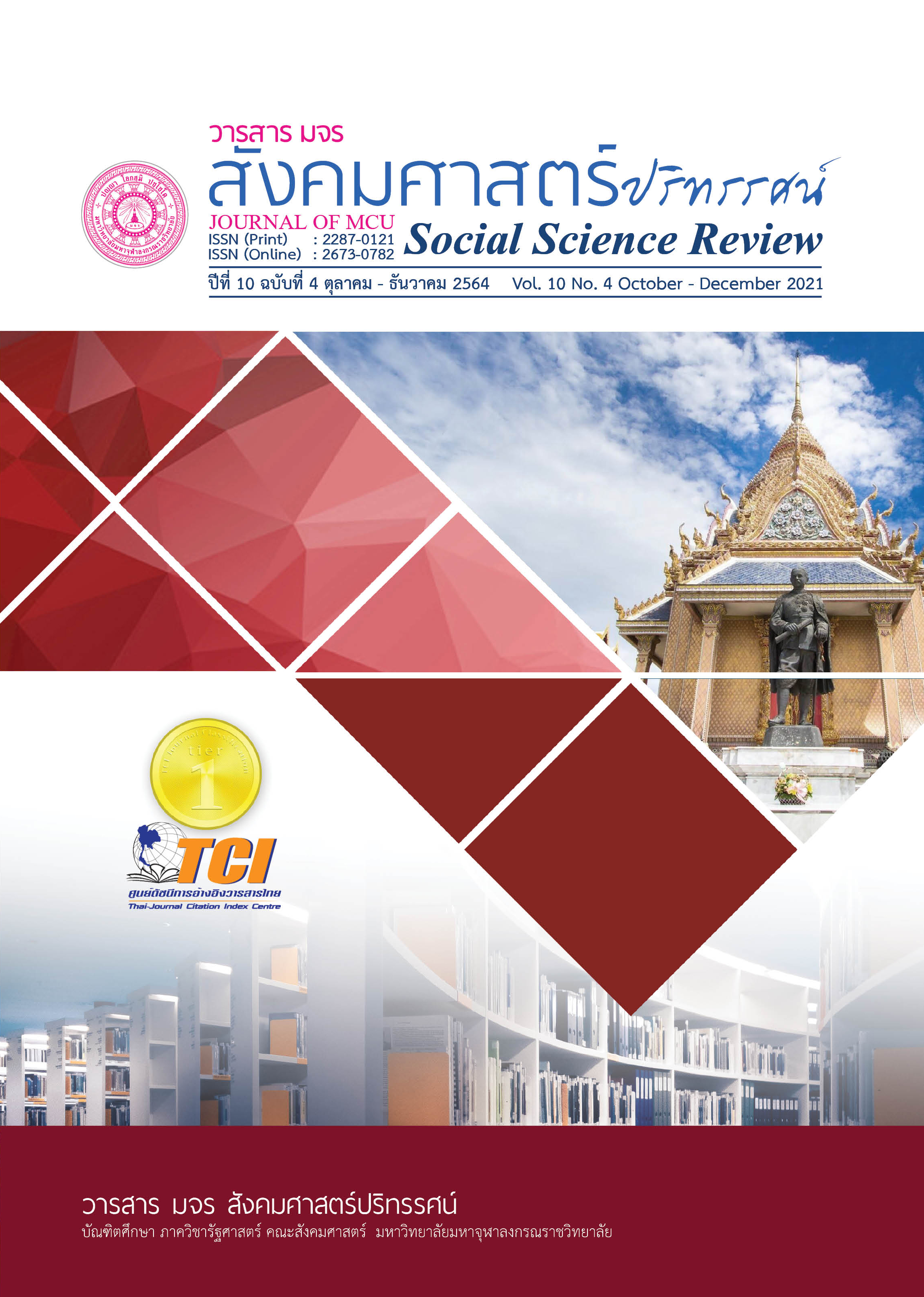รูปแบบการบริหารจัดการงานสงเคราะห์ประชาชนตามหลักสังคมสงเคราะห์ เชิงพุทธบูรณาการของคณะสงฆ์จังหวัดพิจิตร
คำสำคัญ:
รูปแบบ, การบริหารจัดการ, งานสงเคราะห์บทคัดย่อ
บทความวิจัยนี้มีวัตถุประสงค์เพื่อศึกษาวิเคราะห์สภาพทั่วไปและปัญหาอุปสรรค พัฒนารูปแบบ และนำเสนอการพัฒนารูปแบบการบริหารจัดการ เป็นการวิจัยแบบผสานวิธี การวิจัยเชิงคุณภาพ เลือกผู้ให้ข้อมูลสำคัญแบบเจาะจง 18 รูปหรือคน และทำการสนทนากลุ่มเฉพาะ 10 รูปหรือคน เก็บรวบรวมข้อมูลด้วยการสัมภาษณ์เชิงลึก วิเคราะห์ข้อมูลเชิงเนื้อหาพรรณนา การวิจัยเชิงปริมาณ สุ่มตัวอย่างด้วยการเปิดตารางสูตรของทาโร่ ยามาเน่ ได้กลุ่มตัวอย่าง 362 รูป เก็บรวบรวมข้อมูลด้วยแบบสอบถาม และวิเคราะห์ข้อมูลด้วยโปรแกรมการวิจัยทางสังคมศาสตร์
ผลการวิจัยพบว่า 1. คณะสงฆ์ขาดแผนงานและการกระจายงานและอนุเคราะห์ส่งเสริมในการช่วยเหลือเกื้อกูลประชาชนทั้ง 4 ด้านให้แก่ชุมชนไม่ทั่วถึงครอบคลุมทุกพื้นที่ 2. การพัฒนารูปแบบการบริหารจัดการงานสงเคราะห์ประชาชนโดยภาพรวมอยู่ในระดับมาก (= 4.28, S.D. = 0.586) 3. นำเสนอการพัฒนารูปแบบการบริหารจัดการงานสงเคราะห์ประชาชนตามหลักสังคมสงเคราะห์เชิงพุทธบูรณาการของคณะสงฆ์จังหวัดพิจิตร พบว่า ด้านทาน คณะสงฆ์ช่วยเหลือประชาชนผู้ประสบภัยพิบัติในหลายพื้นที่ ๆ ด้านปิยวาจา พระสงฆ์รู้จักประนีประนอมพูดถ้อยทีถ้อยอาศัยต่อกัน ด้านอัตถจริยา คณะสงฆ์ไม่เห็นแก่ประโยชน์ส่วนตัว เห็นแก่ประโยชน์ส่วนรวม ส่งเสริมสัมมาชีพเพื่อพัฒนาเศรษฐกิจชุมชน ด้านสมานัตตตา พระสังฆาธิการปฏิบัติตนเรียบง่าย เข้าถึงง่าย ไม่ถือตน พร้อมให้คำปรึกษาต่อประชาชนตลอดเวลา
เอกสารอ้างอิง
กรมการศาสนา กระทรวงศึกษาธิการ. (2542). คู่มือพระสังฆาธิการว่าด้วยพระราชบัญญัติ กฎ ระเบียบ และคำสั่งของคณะสงฆ์. กรุงเทพฯ: โรงพิมพ์การศาสนา.
คะนึงนิตย์ จันทรบุตร. (2532). สถานะและบทบาทของพระพุทธศาสนาในประเทศไทย. กรุงเทพฯ: ภาพพิมพ์.
จามร ช้างมงคล. (2564). ความพึงพอใจของประชาชนต่อการจัดการงานสาธารณูปการของวัดเวฬุวนาราม อำเภอดำเนินสะดวก จังหวัดราชบุรี. วารสารพุทธนวัตกรรมและการจัดการ, 4(1), 10-17.
พระครูพิศิษฏ์ประชานาถ (ประยูร นนฺทิโย). (2563). สภาพทั่วไปการมีส่วนร่วมของพระสงฆ์ในการพัฒนาชุมชนจังหวัดสมุทรสงคราม. วารสารสหวิทยาการนวัตกรรมปริทรรศน์, 3(2), 50-59.
พระทรงศักดิ์ ถิรธมฺโม. (2564). ผลสัมฤทธิ์จากการปฏิบัติธรรมของประชาชนที่วัดมเหยงคณ์จังหวัดพระนครศรีอยุธยา. วารสารพุทธนวัตกรรมและการจัดการ, 4(1), 57-64.
พระปลัดชุมพล อาภทฺธโรและคณะ. (2561). การสร้างแรงจูงใจตามหลักพุทธธรรมให้แก่ประชาชนในการทำบุญของวัดพุน้อย อำเภอบ้านหมี่ จังหวัดลพบุรี. วารสารสหวิทยาการนวัตกรรมปริทรรศน์, 1(2), 1-10.
พระมหาเสริมชัย ชยมงฺคโล. (2538). การบริหารวัด (พิมพ์ครั้งที่ 2). กรุงเทพฯ: มูลนิธิพุทธภาวนาวิชชาธรรมกายและธนาคารสหธนาคารจำกัดมหาชน.
พระสุคนธ์ ญาณาวุโธและคณะ. (2563). การส่งเสริมประชาชนในการดำเนินชีวิตตามหลักฆราวาสธรรมของพระสงฆ์ อำเภอโพธาราม จังหวัดราชบุรี. วารสารสหวิทยาการนวัตกรรมปริทรรศน์, 3(2), 25-39.
อดุลย์ วังศรี. (2546). การสังเคราะห์งานวิจัยเกี่ยวกับกระบวนการเรียนรู้ ของชุมชนที่ทำให้ชุมชนเข้มแข็ง :การวิจัยเชิงชาติพันธุ์วรรณาอภิมาณ (ดุษฎีนิพนธ์ปริญญาครุศาสตรดุษฎีบัณฑิต สาขาวิชาพัฒนาศึกษา). กรุงเทพฯ: จุฬาลงกรณ์มหาวิทยาลัย.
ดาวน์โหลด
เผยแพร่แล้ว
รูปแบบการอ้างอิง
ฉบับ
ประเภทบทความ
สัญญาอนุญาต
ลิขสิทธิ์ (c) 2021 วารสาร มจร สังคมศาสตร์ปริทรรศน์

อนุญาตภายใต้เงื่อนไข Creative Commons Attribution-NonCommercial-NoDerivatives 4.0 International License.
เพื่อให้เป็นไปตามกฎหมายลิขสิทธิ์ ผู้นิพนธ์ทุกท่านต้องลงลายมือชื่อในแบบฟอร์มใบมอบลิขสิทธิ์บทความให้แก่วารสารฯ พร้อมกับบทความต้นฉบับที่ได้แก้ไขครั้งสุดท้าย นอกจากนี้ ผู้นิพนธ์ทุกท่านต้องยืนยันว่าบทความต้นฉบับที่ส่งมาตีพิมพ์นั้น ได้ส่งมาตีพิมพ์เฉพาะในวารสาร มจร สังคมศาสตร์ปริทรรศน์ เพียงแห่งเดียวเท่านั้น หากมีการใช้ภาพหรือตารางหรือเนื้อหาอื่นๆ ของผู้นิพนธ์อื่นที่ปรากฏในสิ่งตีพิมพ์อื่นมาแล้ว ผู้นิพนธ์ต้องขออนุญาตเจ้าของลิขสิทธิ์ก่อน พร้อมทั้งแสดงหนังสือที่ได้รับการยินยอมต่อบรรณาธิการ ก่อนที่บทความจะได้รับการตีพิมพ์ หากไม่เป็นไปตามข้อกำหนดเบื้องต้น ทางวารสารจะถอดบทความของท่านออกโดยไม่มีข้อยกเว้นใดๆ ทั้งสิ้น





